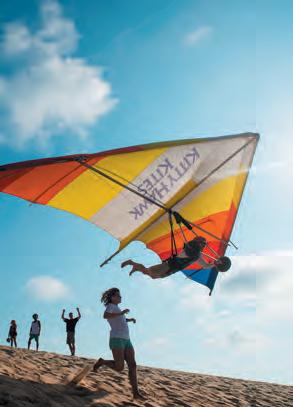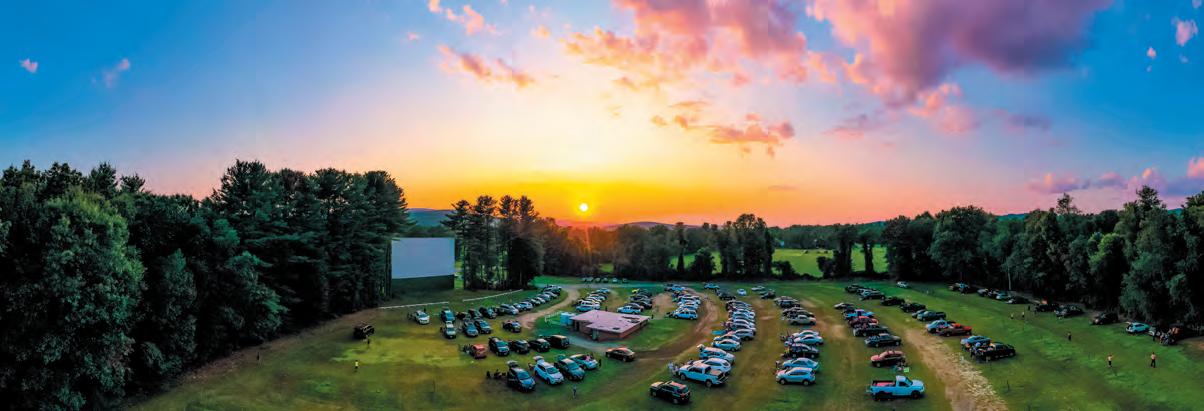8 minute read
Energy Sense
from 2021-06-JUN
Next Article


Three Ways to Save Energy Outdoors
Find efficiencies outside
By Pat Keegan and Brad Thiessen
It’s summertime, and after far too many months cooped up, many North Carolinians are spending more time out in the yard, in gardens, and on decks and patios. We often use this column to discuss ways to save energy indoors, but there are ways to save outside of your home as well — here are three:
1Outdoor Lighting If you have security lighting, there’s a good chance you can save a little energy. Some security lights can be 500 to 1000 watts. That’s the equivalent of 40 to 80 indoor LED bulbs — quite a lot of energy! Adding timers, motion sensors and light sensors can reduce your bulb energy use. Plus, when you use your lights less often, your neighbors may appreciate a little less light pollution!
Switching to LEDs is another great strategy. Solar lights are also a good way to light walkways, a water feature or your deck — without having to buy any electricity at all. 2Grilling Using your oven can raise your kitchen’s temperature by up to 10 degrees, increasing the need for running your air conditioner, so grilling outdoors is a great way to save energy. If you like to grill most of your meals, you may want to consider the fuel you use. If natural gas is available, it’s usually much less expensive than propane. Natural gas is also convenient because you don’t have to refill any tanks like you would with propane. On the downside, if you don’t already have gas lines running to your patio or deck, the cost of installing them can be prohibitive.
Other fuel types, like charcoal briquettes or wood, take more preparation and can be fussy to work with, and charcoal grills emit three times as much carbon as gas grills.
Whichever fuel type you choose for your grill, you can save energy by keeping the lid closed during cooking, rather than cooking with the lid off at higher heat. 3Pumps and maintenance Many of us have one or more pumps that service our yard or reside on our property. Pumps can supply water for a swimming pool, your lawn and garden, or your septic system or well. It’s easy to let maintenance slip, which cuts the pump’s efficiency and shortens its life.
Maintaining pumps involves cleaning the filters or checking oil and belts. If you have multiple pumps and need to hire a professional for assistance, try to do all the maintenance at once to reduce the overall cost. You may also want to consider replacing older pumps with energy efficient Energy Star®-rated ones before they break down. While you’re at it, check for leaks in the water lines, which make your pumps work harder and longer.
Hopefully these ideas will help you enjoy your outdoor living space this summer — and help you save energy!
This column was co-written by Pat Keegan and Brad Thiessen of Collaborative Efficiency. Visit carolinacountry.com/your-energy for more ideas on energy efficiency.

New Life on the Water

Tanya Binford’s surprising path to becoming a record-setting sailor
By Pamela A. Keene
Tanya Binford
After a romantic date in 1996 on a sailboat in San Francisco Bay, Tanya Binford was hooked on boating. But it would be a couple of decades before her real on-the-water adventures began.
“I always dreamed of just sailing away after that first time on a sailboat, but my life certainly took a very different turn in 2014.”
Tanya, who never boated growing up, accomplished what less than 2,000 people have done since the mid-1980s, typically with at least one other person on board. She circumnavigated the Great Loop up the Eastern Coast of the United States, becoming the first female to boat the 5,500-mile route solo. Her six-month journey took her from North Carolina, up along the East Coast and through three of the Great Lakes, south along the Mississippi River to the Gulf of Mexico, around Florida, then back up the East Coast.
“Circumnavigating the Eastern United States has become popular since the late 1990s,” says Kim Russo, director of the America’s Great Loop Cruisers Association, based in Summerville, South Carolina. “But what Tanya has done, especially by herself, is a true accomplishment. She must really have a strong sense of adventure to do such an amazing journey.”
Approaching age 50, Tanya was working as a psychiatric nurse practitioner in Tucson when the death of a dear friend caused her to reassess her life.
“I had too many friends and colleagues who had died before retiring and being able to live their dreams,” she says. “I asked myself, would I have any regrets as I lay on my own deathbed? That was a turning point, and reignited my dream of sailing.”
Enter Annabelle
In 2010, it became necessary for her to see patients virtually, freeing her to live wherever she chose. She took the opportunity to move to Southport, North Carolina, with her son.
“I immediately felt at home in Southport, and within a month I’d bought a house. That was the beginning of my journey. My son and I came here to learn about boats.”
Fast forward to 2014. The deal she’d struck with her employer in Arizona several years before allowed her to take a sabbatical for her extended boat trip. Her goal? Navigate The Great Loop on her own boat, Annabelle, a small trawler equipped with a sleeping berth, galley and bathroom.
“It was about right for me, but tight quarters with other people on board,” she says about the 25-foot, 2008 Ranger Tug.
She learned about navigation, general boat maintenance and safety on the water. She also connected with other “Loopers” (people who were in process of doing The Great Loop or had completed it).
“[I met] so many supportive boaters who were willing to share their experiences — good and bad,” Tanya says. “Without connecting with these people, some of whom became my friends along the way, I never would have made it.”
The voyage begins By April 2014, she was ready to depart. Armed with her boating experience, navigation charts, a tentative schedule with reservations at various marinas and plenty of advice from other people, she headed out of Southport, north into the Intercoastal Waterway.
“The next six months were filled with all kinds of challenges and opportunities,” she says. “I learned how to repair the engine; I survived strong storms and dense fog; and I took plenty of time to enjoy the journey.”
The trip included many one-night stays in marinas or on moorings, but she also had extended overnight stops just because she wanted to get to know more about the communities she passed by.
“I couldn’t imagine being in all these places without learning more about them,” she says. “The thrill of seeing the Statue of Liberty from a boat and cruising the Chicago river through the towering skyscrapers of downtown Chicago can’t be replicated.”
Asked about the challenges, she relayed several stories about negotiating the canals and locks.
“My toughest was in the Erie Canal. The lockmasters for the most part were helpful, but the pressure on me to manage my own vessel, tie off correctly and hold my own was pretty intense.”
2021
Crossing her wake In November 2014, almost six months from the day she left, Tanya ‘crossed her wake,’ meaning she had come life, living in France and exploring the canals and rivers there.” She adds: “I never would have dreamed my life would turn out this way.” full circle and returned to Southport. She had earned the coveted gold flag awarded by the America’s Great Loop Cruisers Association to signify completion of the Loop.
Once home, she wrote the book “Crossing the Wake,” an account of her journey. She returned to work for a few more years, but last November, she retired to embark on her next adventure.
“I’ve sold everything and have my new canal barge waiting for me on the Saone River in France,” she says. There’s a longing in her voice. “I’d be there already, but with the pandemic I have to be patient. The positive is that the delay allows more time for French lessons. The wait will be so worth it to begin this next stage of my
Pamela A. Keene is a freelance journalist who writes for magazines and newspapers across the Southeast and nationally.

The 5,500-mile Great Loop
Visit greatloop.org to see an interactive map of the route followed by Tanya and other Loopers, and to learn more about America’s Great Loop. Her book is available at crossingthewake.com.
Nothing could be finer ...
Carolina Country is proud to offer up our third annual Carolina’s Finest Awards, showcasing the finest North Carolina has to offer. We need your help! We’re leaving it up to you, our readers, to pick the best of the best. Visit carolinacountry.com/finest by June 30 and cast your votes in the categories below. Each voter will be entered into a drawing for one of three $100 gift cards.

Categories include:
BBQ
Burger Bakery Festival Weekend Getaway Main Street/Downtown Family Friendly Outing Public Garden Iconic NC Landmark Made in NC Product
Vote for your favorites at
carolinacountry.com/finest
by June 30 for a chance to win $100!
NO PURCHASE NECESSARY. To enter, complete online entry form at carolinacountry.com/finest, or mail in your votes to Carolina Country’s Finest, 3400 Sumner Blvd., Raleigh, NC 27616, for a chance to win. All contact information will remain confidential. One entry per person, drawn by random; odds of receiving one (1) of the three $100 gift cards depend upon number of entries received. Entries must be submitted by June 30, 2021. Random drawing will take place July 1, 2021.









